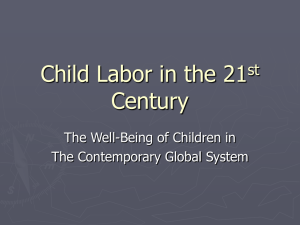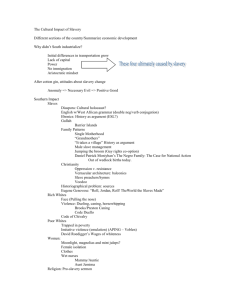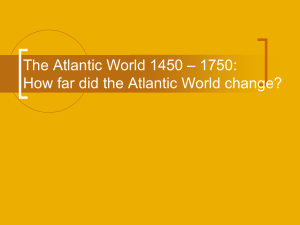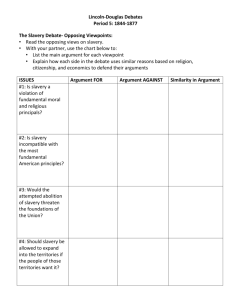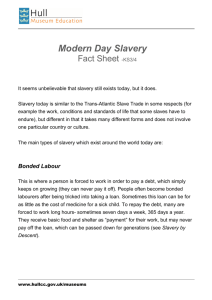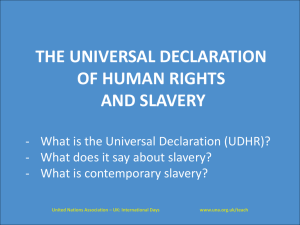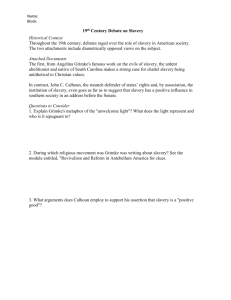Fact Sheet No.14, Contemporary Forms of Slavery Slavery: the
advertisement
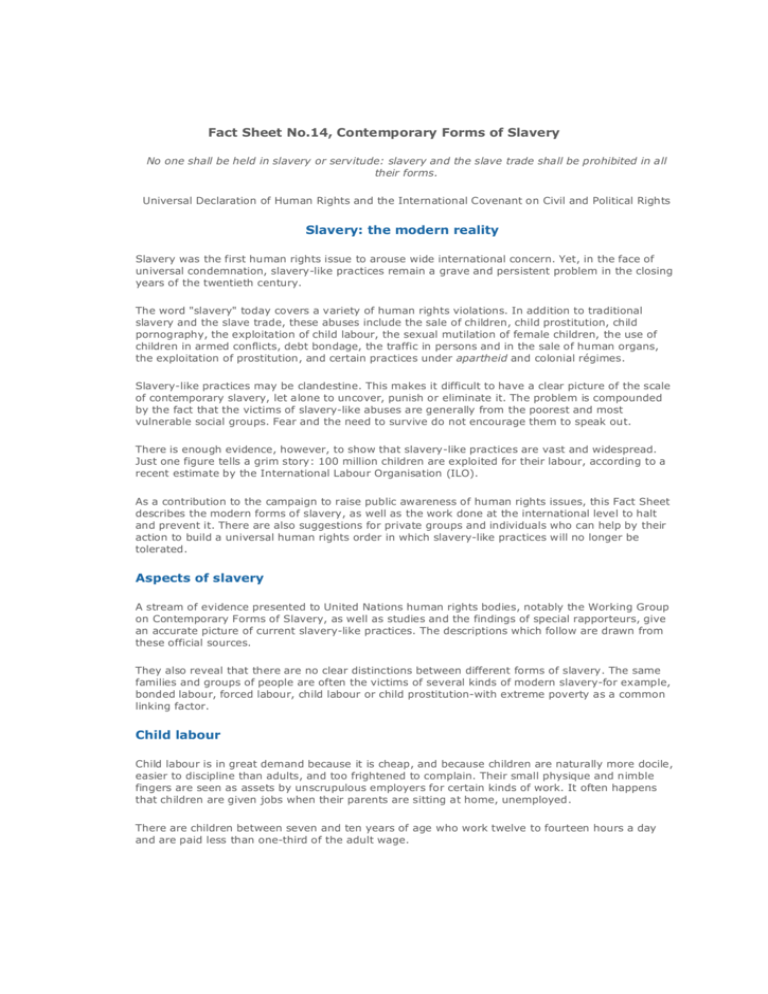
Fact Sheet No.14, Contemporary Forms of Slavery No one shall be held in slavery or servitude: slavery and the slave trade shall be prohibited in all their forms. Universal Declaration of Human Rights and the International Covenant on Civil and Political Rights Slavery: the modern reality Slavery was the first human rights issue to arouse wide international concern. Yet, in the face of universal condemnation, slavery-like practices remain a grave and persistent problem in the closing years of the twentieth century. The word "slavery" today covers a variety of human rights violations. In addition to traditional slavery and the slave trade, these abuses include the sale of children, child prostitution, child pornography, the exploitation of child labour, the sexual mutilation of female children, the use of children in armed conflicts, debt bondage, the traffic in persons and in the sale of human organs, the exploitation of prostitution, and certain practices under apartheid and colonial régimes. Slavery-like practices may be clandestine. This makes it difficult to have a clear picture of the scale of contemporary slavery, let alone to uncover, punish or eliminate it. The problem is compounded by the fact that the victims of slavery-like abuses are generally from the poorest and most vulnerable social groups. Fear and the need to survive do not encourage them to speak out. There is enough evidence, however, to show that slavery-like practices are vast and widespread. Just one figure tells a grim story: 100 million children are exploited for their labour, according to a recent estimate by the International Labour Organisation (ILO). As a contribution to the campaign to raise public awareness of human rights issues, this Fact Sheet describes the modern forms of slavery, as well as the work done at the international level to halt and prevent it. There are also suggestions for private groups and individuals who can help by their action to build a universal human rights order in which slavery-like practices will no longer be tolerated. Aspects of slavery A stream of evidence presented to United Nations human rights bodies, notably the Working Group on Contemporary Forms of Slavery, as well as studies and the findings of special rapporteurs, give an accurate picture of current slavery-like practices. The descriptions which follow are drawn from these official sources. They also reveal that there are no clear distinctions between different forms of slavery. The same families and groups of people are often the victims of several kinds of modern slavery-for example, bonded labour, forced labour, child labour or child prostitution-with extreme poverty as a common linking factor. Child labour Child labour is in great demand because it is cheap, and because children are naturally more docile, easier to discipline than adults, and too frightened to complain. Their small physique and nimble fingers are seen as assets by unscrupulous employers for certain kinds of work. It often happens that children are given jobs when their parents are sitting at home, unemployed. There are children between seven and ten years of age who work twelve to fourteen hours a day and are paid less than one-third of the adult wage. Child domestic servants not only work long hours for a pittance but are particularly vulnerable to sexual as well as other physical abuse. At the extreme fringe, children are kidnapped, held in remote camps, and chained at night to prevent their escape. They are put to work on road-building and stone-quarrying. Child labour, often hard and hazardous, damages health for life, deprives children of education and the normal enjoyment of their early years. Non-governmental organizations have proposed an international timetable for the wiping out of the worst forms of child exploitation. They suggest that: All forced labour camps be eliminated within 12 months; Children be excluded from the most hazardous forms of work, as defined by the World Health Organization (WHO) and the ILO, by 1995; All forms of labour for children under 10 outlawed by ILO Convention No. 138 be eliminated, and that those regarding children in the 10-14 age group be halved by the year 2000. Children in armed conflict Forcible recruitment of children into military service has been reported in many parts of the world. The consequences are devastating. Many have died or been disabled in armed operations, while others have been interrogated, tortured, beaten, or kept as prisoners of war. The traffic in persons, sexual exploitation The recruitment, clandestine transport and exploitation of women as prostitutes, and the organized prostitution of children of both sexes in a number of countries is well documented. A link has been established in some places between prostitution and pornography-particularly involving children-and the promotion and growth of tourism. Sale of children Unscrupulous go-betweens have found that large profits can be made by arranging the transfer of children from poverty-stricken homes to people with means-without guarantees and supervision to ensure that the child's interests will be protected. In such cases, financial gain-for the parents as well as the intermediaries-takes on the character of trading in children. Debt bondage Debt bondage can hardly be distinguished from traditional slavery because it prevents the victim from leaving his job or the land he tills until the money is repaid. Although in theory a debt is repayable over a period of time, a situation of bondage arises when in spite of all his efforts, the borrower cannot wipe it out. Normally, the debt is inherited by the bonded labourer's children. Sharecropping is a familiar way of leading borrowers into debt bondage. Apartheid and colonialism Apartheid is not simply a racial discrimination problem to be solved through education and political reform. In essence, apartheid has dispossessed the black population of South Africa by imposing a quasi-colonial system. Through coercive measures, the labour of the indigenous peoples has been harnessed for the profit of white investors. By suppressing the human rights of entire populations, apartheid and other forms of colonialism have the effect of collective or group slavery. A pernicious quality is that the subject peoples have no choice: they are born into a state of slavery and have very little, if any, means of appeal against it. Slavery: a state of mind As a legally-permitted labour system, traditional slavery has been abolished everywhere, but it has not been completely stamped out. There are still reports of slave markets. Even when abolished, slavery leaves traces. It can persist as a state of mind-among its victims and their descendants and among the inheritors of those who practised it-long after it has formally disappeared. International conventions International concern with slavery and its suppression is the theme of many treaties, declarations and conventions of the nineteenth and twentieth centuries. The first of three modern conven-tions directly related to the issue is the Slavery Convention of 1926, drawn up by the League of Nations. With the approval of the General Assembly, the United Nations formally became the successor to the League in the application of the Slavery Convention in 1953. States which have ratified the Convention-by 1990 86 had done so-undertake to prevent and suppress the slave trade and to bring about the abolition of slavery in all its forms. In 1949, the General Assembly adopted the Convention for the Suppression of the Traffic in Persons and of the Exploitation of the Prostitution of Others. This legal instrument consolidated other international agreements dating back to 1904. The procurer rather than the prostitute is the target of the Convention. It requires States Parties to introduce measures designed to prevent prostitution and to rehabilitate prostitutes. States ratifying or acceding to the Convention-they numbered 60 by the end of 1990-also undertake to check the traffic in persons of either sex for the purpose of prostitution and to do away with laws, regulations, special registration, and other requirements of persons who are engaged-or suspected of engaging-in prostitution. The 1926 Convention's definition of slavery was broadened to include the practices and institutions of debt bondage, servile forms of marriage, and the exploitation of children and adolescents in the Supplementary Convention on the Abolition of Slavery, the Slave Trade, and Institutions and Practices Similar to Slavery, adopted at a United Nations conference in Geneva in 1956. The Supplementary Convention has been ratified or acceded to by 106 States. The Working Group on Contemporary Forms of Slavery is the United Nations body which receives information from States on the steps they have taken to implement the three slavery-related Conventions. A number of other relevant Conventions have been adopted and are supervised by ILO. Other means of protection Protection against abuses of human rights which fall within the broad definition of slavery is a feature of the Universal Declaration of Human Rights and the International Covenant on Civil and Political Rights, the International Covenant on Economic, Social and Cultural Rights, the Convention on the Elimination of All Forms of Discrimination against Women, and the Convention on the Rights of the Child. Committees established under each Covenant and Convention monitor their implementation by the States Parties. In addition, there are United Nations channels for receiving specific complaints of violations of human rights, including those which merit the name of slavery. The Convention on the Rights of the Child, which entered into force on 2 September, 1990, deserves special mention as the most recent and potentially one of the most effective means of combating slavery-like practices, taking into account the number of child victims. Properly implemented by States which have ratified it, the Convention offers protection to children at risk from sexual, economic, and other forms of exploitation, including their sale, trafficking and involvement in armed conflict. (The texts of these international legal instruments and descriptions of the work of United Nations human rights bodies which monitor their application, as well as the procedures for communicating complaints of human rights violations to the United Nations are found in other publications in the Fact Sheet series. A list of titles of Fact Sheets already published is given on the inside back cover.) Action in the United Nations The Working Group on Contemporary Forms of Slavery* has the general responsibility in the United Nations for the study of slavery in all its aspects. Meeting for the first time in 1975 as the Working Group on Slavery, the group was renamed in 1988. The Working Group consists of five independent experts* chosen on the basis of fair geographical representation from the membership of the Sub-Commission on Prevention of Discrimination and Protection of Minorities. The group meets for one week each year and reports to the SubCommission. * In 1990, the members of the Working Group were: Fatma Zohra Ksentini (Algeria) (chairperson/rapporteur), Ion Diaconu (Romania), Asbjorn Eide (Norway), Waleed M. Sadi (Jordan), Suescun Monroe (Colombia). In addition to monitoring the application of the slavery conventions and making a review of the situation in different parts of the world, the group selects a theme for special attention each year. In 1989, the theme was prevention of the sale of children, child prostitution and child pornography, and in 1990, eradication of the exploitation of child labour and debt bondage. The 1991 theme is the prevention of the traffic in persons and exploitation of the prostitution of others. Programmes of national and international action to deal with the problems raised by the first two themes have been drafted by the Working Group, which expects to receive reactions to its proposals from governments and a wide range of organizations. In 1992, the Working Group expects to evaluate its study of the three themes and to take up the idea of an international pledging conference to help put an end to the exploitation of child labour. Special rapporteurs On the Working Group's recommendation, the Commission on Human Rights appointed Vitit Muntarbhorn in 1990 as special rapporteur on the sale of children, child prostitution and child pornography, and the problem of the adoption of children for commercial purposes. He is due to report his findings and recommendations to the Commission in 1992. This is the latest in a series of investigations, set in motion by the Working Group, which have shed light on contemporary forms of slavery, and proposed means of combating it. In 1982, Benjamin Whitaker's updated report on slavery covered a range of topics, including forced labour, illicit trafficking in migrant workers, slavery-like practices involving women such as forced marriage, the sale of women and killings for reasons of dowry, and the genital mutilation of female children. The exploitation of child labour was investigated by Abdelwahab Boudhiba. In his 1981 report to the Sub-Commission on Prevention of Discrimination and Protection of Minorities he demonstrated that work done by children is often traumatic, and perverts the notions of work as a liberating force or as a means of development towards maturity. Suppression of the traffic in persons and the exploitation of the prostitution of others was the subject of a report by Jean-Fernand Laurent to the Economic and Social Council. The Working Group is expected to take his recommendations into account in developing this theme in 1991. At the invitation of the Government, a United Nations mission visited Mauritania in 1984 to study the country's needs in eliminating the consequences of slavery. Recommendations Among proposals for future action, the Working Group has recommended that: A voluntary or trust fund be created which would make it possible for more directly-concerned organizations to take part in the Working Group's activities; Where child labour might be involved-as in the making of carpets-the product should bear a special mark certifying that children have not been employed. Consumers should be alerted to demand products so marked; Information campaigns for the boycotting of goods produced on the basis of exploited child labour be launched; A seminar or workshop on debt bondage be organized by ILO in co-ordination with other United Nations bodies; United Nations organs, specialized agencies, development banks and other intergovernmental bodies avoid the involvement of bonded labour in development projects with which they are concerned, and contribute to its elimination; States co-operate in drawing up a convention on inter-country adoption as proposed at the Hague Conference on Private International Law. Sources of information In studying the current problems of slavery, setting priorities in its work, establishing the facts and making recommendations, the Working Group gathers information from a variety of sources. Governments co-operate and participate in its work, as do various United Nations bodies, intergovernmental organizations and nongovernmental organizations (NGOs). Statements by governments have revealed their interest in and support for projects to help the victims of slavery-like practices. Governments also provide information on changes in domestic law designed to prevent or give better protection against these practices. Other government initiatives have concerned requests for advisory services in implementing United Nations conventions, coordination within the United Nations system in combating the traffic in persons, and putting the issue of sexual exploitation on the agenda of the Council of Europe. NGOs make an important contribution to the Working Group's activities. At its sessions, they inform the Working Group of the situation as they see it in many parts of the world and describe their work and experience in eliminating practices condemned in the slavery conventions. Their involvement is in such areas as legal aid and assistance for children affected by states of emergency; rehabilitative services for children caught up in armed conflict; campaigns for the abolition of child prostitution; assistance in framing legislation on inter-country adoptions; and development assistance programmes for children who run the risk of sexual exploitation. The Working Group also benefits from the information provided by the specialized agencies. International co-operation Efforts to eliminate contemporary forms of slavery involve a wide spectrum of international organizations, which have their own fields of action and which collaborate with the Working Group. International Labour Organisation (ILO) ILO has adopted two conventions which require the ratifying States to suppress and not to make use of any form of forced or compulsory labour. Convention No. 29 of 1930 prohibits forced labour in most of its forms, and Convention No. 105 of 1957 forbids its use for development. Each has received more than 100 ratifications. The ILO 1973 Minimum Age Convention is designed to prevent the exploitation of child labour. It sets the minimum age for work at not less than the age of completion of compulsory schooling and in any case not less than 15 years (14 years for developing countries), and for work "likely to harm health, safety or morals" at not less than 18 years. Governments report to ILO on the steps they take to comply with these international legal instruments. The reports are examined by the Committee of Experts on the Application of Conventions and Recommendations and by the International Labour Conference, and any problems are followed up until they are resolved. ILO also carries out an active programme of technical assistance to combat child labour, bonded labour, and other unacceptable forms of exploitation. ILO supplies information to the Working Group on Contemporary Forms of Slavery; in return, the proceedings of the Working Group throw light on the extent to which ILO conventions are being observed and on cases where ILO may offer assistance in solving problems. World Health Organization (WHO) WHO has confirmed at Working Group hearings that sex exploitation, debt bondage, the sale of children and the condition of apartheid all present grave risks to the mental health and social development of the children involved. Exploitation for sexual ends also adds to the risk of spreading the human immunodeficiency virus (HIV) and AIDS. In addition to an offer to study the problem of child prostitution, and develop approaches on prevention and the treatment of health hazards, WHO and its regional offices are in a position to provide technical support for specific projects. Guidelines are also being prepared by WHO on the issue of trafficking in human organs for transplantation purposes. United Nations Educational, Scientific and Cultural Organization (UNESCO) Slavery and slavery-like practices have been the subject of meetings and reports prepared under UNESCO auspices. As one example, UNESCO has sponsored a study by the International Catholic Child Bureau on the protection of minors from pornography. In 1988, a UNESCO meeting studied the effects of armed conflict on children and recommended action to protect and promote their rights in such situations. UNESCO is organizing in 1991 a meeting on the 1949 Convention on the Suppression of the Traffic in Persons and the Exploitation of the Prostitution of Others. The aim is to make proposals to improve implementation of the Convention. Food and Agriculture Organization (FAO) FAO's approach relates to servitude of children and debt bondage in connection with existing forms of land tenure. FAO activities which promote people's participation and give assistance to small farmers' organizations are seen as effective counter-measures to debt bondage. United Nations Children's Fund UNICEF) The role of UNICEF is crucial to international strategies to deal with the contemporary forms of slavery. UNICEF arranged massive support for the adoption and rapid ratification of the Convention on the Rights of the Child and organized the World Summit for Children in New York in September, 1990. The Summit approved at the highest political level a Declaration and Plan of Action for the survival, protection and development of children in the nineteen-nineties. In the Plan of Action, States are committed to work to ease the plight of millions of children who live under especially difficult circumstances-as orphans and street children, refugees or displaced persons, victims of war and natural and man-made disasters ... children of migrant workers and other socially disadvantaged groups, as child workers or youth trapped in the bondage of prostitution, sexual abuse and other forms of exploitation, as disabled children or juvenile delinquents and as victims of apartheid and foreign occupation. Office of the United Nations High Commissioner for Refugees (UNHCR) A standing group of UNHCR monitors the situation of refugee children and the particular problems they encounter. Guidelines to UNHCR field offices on refugee children include the issues of recruitment in armed conflict and the adoption of unaccompanied minors. United Nations Commission on the Status of Women Problems akin to slavery which affect women in particular receive continued attention from the Commission on the Status of Women, and have featured in the debates, conclusions and recommendations of the World Conferences of the United Nations Decade for Women in Mexico City, Copenhagen and Nairobi. The Commission submits information to the Working Group on Contemporary Forms of Slavery. United Nations Crime Prevention and Criminal Justice Branch In its study of child victimization, including trafficking in and the sale of children, this branch of the United Nations identifies four fields of counteraction by the machinery of justice. These are prevention; treatment and redress for victims; legal sanctions for alleged offenders; and treatment and rehabilitation of offenders. International Criminal Police Organization (INTERPOL) INTERPOL provides information on slavery-like practices to the Working Group under a co-operative arrangement with the United Nations. Information has included the report of the 1988 International Symposium on Traffic in Human Beings, where child pornography was discussed. The symposium urged law enforcement agencies to give priority to investigations into the international market for pornographic material with the emphasis on the welfare of the child. It was recommended that prevention of the sexual abuse of children should be included in the public awareness campaigns of law enforcement agencies. INTERPOL is making a study of ways to improve international co-operation in preventing and punishing offences against minors, and will communicate the results to the Working Group. A role for everyone The essential base of international covenants, national legislation and enforcement procedures is established, but long experience has shown that official action alone will not stamp out slavery in its various forms. Attitudes and customs often deep-rooted-must change. People moved by the plight of the victims of modern forms of slavery-particularly where children are concerned-are constantly writing to the United Nations. In their letters they often ask the question: "What can I do?" The answer is that everyone has a contribution to make to a world order which no longer tolerates inhumane exploitation. There are many things that can be done at the national and local levels, by associations and by individuals. Here are a few suggestions: Help to set up national commissions to protect and promote human rights, particularly those of people in the most vulnerable groups, which include children, women, indigenous peoples, and debt-bonded labourers. Encourage religious and lay organizations to be active in making their members and the public aware of the inhumane character of widely current forms of exploitation. Propose, through parent-teacher associations, that schools use various techniques, including art exhibitions and essay competitions, to bring home the damaging consequences of slavery-like practices. Organize national art competitions for school children, with the winning entries used to illustrate posters and postage stamps. On Human Rights Day, 10 December (anniversary of the proclamation of the Universal Declaration of Human Rights in 1948), use the occasion to focus attention on problems of exploitation through slavery-like practices. Concerts could be organized to raise funds for development projects, for advocacy services, training programmes and the establishment of schools. Seek to interest the media-television, radio, newspapers and magazines-in dealing with the issues of exploitation in entertainment as well as in the service of information they provide. Enlist the help of public personalities in their media appearances to promote respect for human rights and to make audiences conscious of the problems of exploitation. Raise the level of concern over exploitative practices and their consequences for the health and development of the people involved, among groups which defend the interests of women, consumers and the tourist industry. Campaign with these and other groups for a special mark or label on certain goods to certify that they have not been produced with child labour. The same groups could help to educate consumers to demand only labelled products. Campaign for the ratification of international human rights covenants and Conventions in countries where this action has not yet been taken. Printed at United Nations, Geneva June 1991

